Polynomial and Synthetic Division - PowerPoint PPT Presentation
Title:
Polynomial and Synthetic Division
Description:
Polynomial and Synthetic Division #3 Common Core objectives: * Students will be able to use long division to divide polynomials by other polynomials. – PowerPoint PPT presentation
Number of Views:643
Avg rating:3.0/5.0
Title: Polynomial and Synthetic Division
1
Polynomial and Synthetic Division
- 3
2
Common Core objectives
- Students will be able to use long division to
divide polynomials by other polynomials. Use
synthetic division to divide polynomials by
binomials of the form (x k). Use the Remainder
Theorem and the Factor Theorem. - Teacher will instruct students to learn about
the process of division. Learn about a couple of
theorems to help in factoring and solving higher
level polynomials
3
Now lets look at another method to divide
- Why???
- Sometimes it is easier
4
Synthetic Division
- Synthetic Division is a shortcut for polynomial
division that only works when dividing by a
linear factor (x b). - It involves the coefficients of the dividend, and
the zero of the divisor.
5
Synthetic Division
- The pattern for synthetic division of a cubic
polynomial is summarized as follows. (The pattern
for higher-degree polynomials is similar.)
most
vertical pattern ADD terms
Diagonal pattern MULTIPLY terms
6
Example
- Divide
- Step 1
- Write the coefficients of the dividend in a
upside-down division symbol.
1
5
6
7
Example
- Step 2
- Take the zero (or root) from the divisor, and
write it on the left, x 1 0 , so the zero is
1.
5
6
1
1
8
Example
- Step 3
- Carry down the first coefficient.
1
5
6
1
1
9
Example
- Step 4
- Multiply the zero by this number. Write the
product under the next coefficient.
1
5
6
1
1
1
10
Example
- Step 5
- Add.
1
5
6
1
1
1
6
11
Example
- Step 6 etc.
- Repeat as necessary
1
5
6
1
1
6
12
1
6
12
step 7
- The numbers at the bottom represent the
coefficients of the answer. The new polynomial
will be one degree less than the original.
1
5
6
1
1
6
12
1
6
13
Using Synthetic Division
- Use synthetic division to divide x4 10x2 2x
4 by x 3. - Solution
- You should set up the array as follows. Note that
a zero is included for the missing x3 term in
the dividend.
14
Example
2x2 3x 4 x - 1
- Divide
- Step 1
- Write the coefficients of the dividend in a
upside-down division symbol.
2
3
4
15
Example
2x2 3x 4 x - 1
- Step 2
- Take the zero (or root) from the divisor, and
write it on the left, x 1 0 , so the zero is
1.
3
4
2
1
16
Example
2x2 3x 4 x - 1
- Step 3
- Carry down the first coefficient.
2
3
4
1
2
17
Example
2x2 3x 4 x - 1
- Step 4
- Multiply the zero by this number. Write the
product under the next coefficient.
2
3
4
1
2
2
18
Example
2x2 3x 4 x - 1
- Step 5
- Add.
2
3
4
1
2
2
5
19
Example
2x2 3x 4 x - 1
- Step 6 etc.
- Repeat as necessary
2
3
4
1
2
5
9
2
5
20
step 7
- The numbers at the bottom represent the
coefficients of the answer. The new polynomial
will be one degree less than the original.
2
3
4
1
2
5
9
2
5
21
Lab Application, practice































